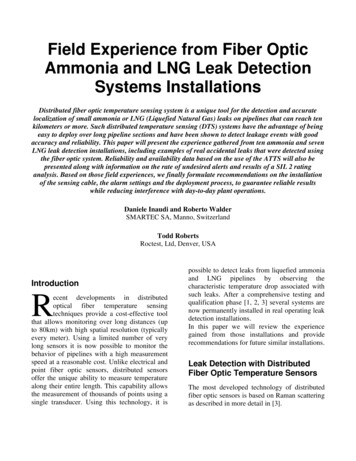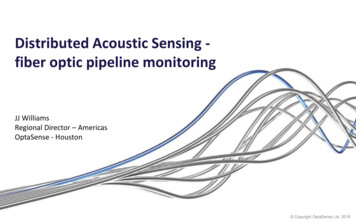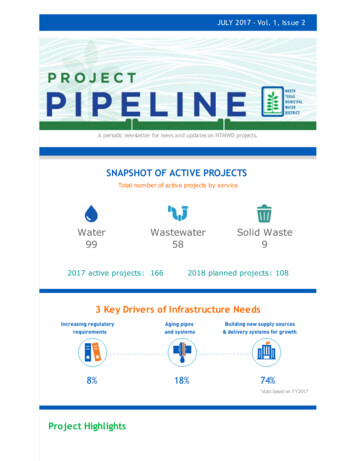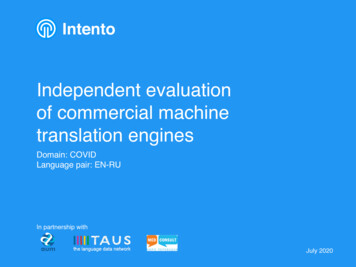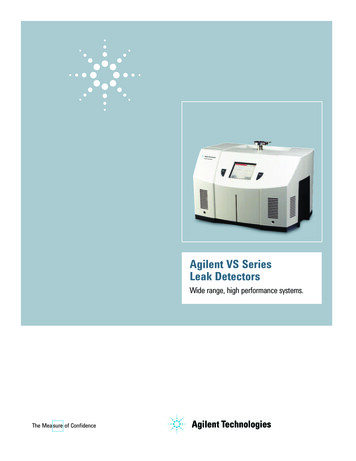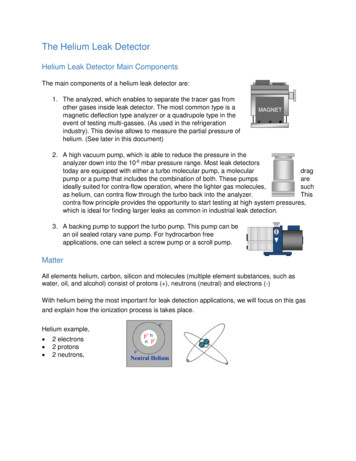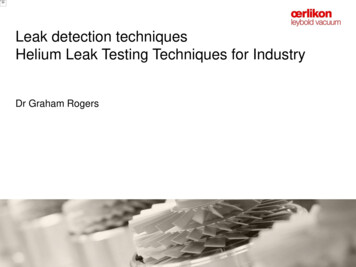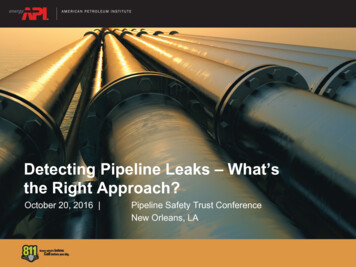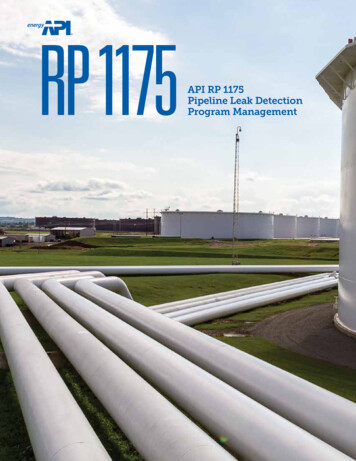
Transcription
RP 1175API RP 1175Pipeline Leak DetectionProgram Management
Cover Photo courtesy ofPlains All American Pipeline
TABLEOFCONTENTSWhy Do We Need It?3The industry focus is prevention, aiming to achievethe goal of zero releases. While operators are takingsignificant steps towards their objective, they musthave a mitigation strategy should a release occur, andthe appropriate leak detection program, composed ofeffective leak detections systems, is a part of successfulmitigation.What Is It?7API RP 1175, Pipeline Leak Detection-ProgramManagement, gives operators valuable guidance on thecomponents needed, with culture and strategy being ofutmost importance.How To Begin?The instruction in API RP 1175 is flexible and scalable,allowing any pipeline operator the opportunity toimplement it. Industry must begin to implement effectiveLD programs, though, by identifying the gaps betweentheir existing program and what is detailed in the RP.Then, industry must take steps to close these, withnecessary reviews at periodic intervals in the program’slife cycle.27
WHYDOWENEEDIT?Leak Detection Programs areessential to minimize releasesMinimize impact of releases on peoplePublic and employeesMinimize impact of releases on the environmentAnimals, plants, waterways, and soilMinimize impact of releases on infrastructureBuildings, roads, bridges, other utilities, and pipelinesDriving industry performance toward a goal of zero releasesWe need systems, processes, and people to detectproblems quickly and resolve them promptlyPhoto courtesy ofPlains All American Pipeline3
WHY WAS THIS RP NEEDED?Pipeline Leak Detection —Program ManagementIt’s not enough to have a Leak Detection (LD)systemIt must be designed and installed appropriatelyVarious operating situations and conditionsIt must be maintained so it works when neededReliability, availability, maintainabilityIt must be tuned so it works as neededAlarms only and always when it shouldPeople must know what to do along with others Roles and responsibilities Documented procedures Training, testing, and drillsLeadership must supportEffective leadership strategy and supportive culture4
Photo courtesy of Plains All American PipelineLeak Detection (LD) Task ForceGuidance document to address concerns of mandate.ProactiveComprehensive integration Establishes a framework forLD program management forpipelinesLD Initiatives & Rulemaking ConsiderationsPHMSA presented to API April 17, 2013, seeking feedback on pathforward. Enhances conformity withregulations; augments(does not replace) existingstandards and requirementsGeneral Accounting Office (GAO) Study"DOT should: 1) improve incident response data and use these datato evaluate whether to implement a performance-based frameworkfor incident response times and 2) share guidance and information onevaluation approaches to inform operators’ decisions."TacticalAnalyze Integrate data Share guidance Decision supportNTSB Recommendation P-11-10"Require that all operators of natural gas transmission and distributionpipelines equip their SCADA systems with tools to assist in recognizingand pinpointing the location of leaks, including line breaks; such toolscould include real-time leak detection system and appropriately spacedflow and pressure transmitters along covered transmission lines."ReactiveHigh-level interestCongressional Mandate"Pipeline Safety, Regulatory Certainty and Job Creation Act of 2011,Section 8 – Leak Detection required to analyze technical, operational,and economic feasibility aspects on leak detection systems "5
WHATIS IT?Overview of Leak Detection ProgramPipeline leak detection shall be managed bystructuring the various elements of leak detectioninto a leak detection programAPI RP 1175 divides a Leak Detection (LD) programinto the following components:LD culture and strategySelection of LD methodsPerformance targets, metrics, and KPIsTestingControl center procedures for recognition and responseAlarm managementRoles, responsibilities and trainingReliability Centered Maintenance (RCM) forLD equipmentOverall performance evaluation of the LD programManagement of changeImprovement processAPI RP 1175 focuses on LD programs, not only LD systemsPhoto courtesy ofMarathon Pipe Line7
LEAKDETECTIONLeak Detection CultureManagement support for the Leak Detection (LD) program– visible and ongoingEmployees understand the LD strategyRecognition and integration of all methodsof leak detectionOngoing support toward improving pipelineleak detection (even if the pipeline operator is meetingleak detection goals)Promotion and endorsement of teamwork withindepartments and across the organizationCollaboration between the different entities involvedin the LD programCulture is maintained by having a healthy senseof vulnerabilityA strong LD culture promotes prompt action to helpreduce the consequences of a leak8
Leak Detection StrategyA written document that promotes the company’sLeak Detection (LD) Culture and transforms it into actionBegins with a gap assessment to identify areasfor improvementOutlines the requirements of the LD programSets goals and establishes timelines and responsibilityDescribes how the company will meet regulatoryrequirements and go beyond the minimum toimplement industry best practicesClearly defined roles, responsibilities, policies,procedures, and processesInvolves strategy planning and strategic thinking9
Photo courtesy of Phillips 66 Pipeline
Key Leak Detection StrategyElementsVisible management commitment and leadershipConsistency with company goals and requirementsHow goals and requirements should be satisfiedEmployment of risk managementSelection of Leak Detection (LD) methodsIntegration of all forms of leak detection employedConsideration of regulatory requirements andindustry standardsOngoing measurement of program's performanceTraining, testing, and operations/proceduresReportingReview and approvalsManagement of changeOngoing improvement11
CurrentLD MethodMeasureEvaluateLD StrategyPerformanceTargetsSelection of Leak Detection MethodsPerform risk assessment with Leak Detection (LD) focusInclude regulatory requirements and best practicesIdentify options for an integrated LD strategyConsider primary, complementary, and alternative LDAssess requirements of individual pipelinesLink to LD strategy performance targetsEvaluate best available technologies to meet LD strategy12
Select LD Technology ContinuousCombinationEvaluating Leak DetectionTechnology OptionsLeak Detection (LD) methodologies and technologiescover a wide range of different approaches and principlesLD methodologies can be classified into internally-basedand externally-based detection principles; They can becontinuous or non-continuousLD options may depend on the complexity of the pipelinesystem and its operationsEvaluate how the options meet your specific pipelinesystem design and its operationsIt is helpful to review LD selection options with otherindustry users, vendors, and consultants13
EstablishTargetsDefineTrack &RevisePerformance Targets, Metrics,and KPIsEstablish performance targets, metrics, and KPIs forthe Leak Detection (LD) systems Draw the line between satisfactory and unsatisfactoryDefine, then track to ensure goals are metRevise as part of a continual improvement processPerformance targets are part of the operator’s strategy,and selection processAPI RP 1130, Annex C defines these metrics as: Sensitivity, reliability, accuracy, and robustnessThe metrics may be applied to any LD systemIn this RP, the terms "metric" and "KPI" are closely related14
ImplementTestVerifyTestingLeak Detection (LD) systems shall be tested whenimplemented, after significant pipeline changes, and on aregular basis not to exceed five yearsTesting shall include the requirements of API RP 1130tailored to the specific pipeline LD system implementationA detailed, rigorous test plan should be developed andexecuted using sound engineering judgmentSome LD systems (such as external) may require systemspecific testing methods or detailed checklist evaluations(see API RP 1162, Annex E)The pipeline operator may also consider methods to testcontrol-room staff and LD response proceduresOpportunity to improve the culture, procedures, and knowledge levels15
Photo courtesy of Phillips 66 Pipeline
the appropriate leak detection program, composed of effective leak detections systems, is a part of successful mitigation. API RP 1175, Pipeline Leak Detection-Program Management, gives operators valuable guidance on the components needed, with culture and strategy being of utmost importance. The instruction in API RP 1175 is flexible and scalable,

